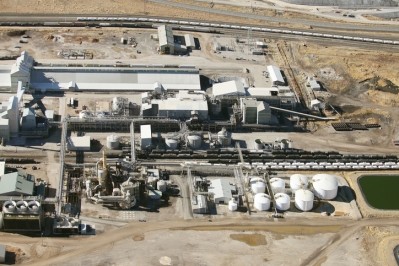Special Edition: Commodities Outlook
Feed phosphate prices could slide on Saudi firm expansion

Juan von Gernet, who heads up research in the phosphate rock, fertilizers and feed markets at consultancy CRU, gave FeedNavigator the low-down on the IFP segment.
He told us Saudi producer, Ma’aden Phosphate Company, has just confirmed it has completed 25% of the construction work on its new phosphate plant.
“The majority of the feed phosphate produced at the facility will enter the export market – the domestic market impact will be minimal - so this kind of extra capacity could have a significant impact on global IFP prices when the plant is operational.
But, of course, it depends on how Ma’aden wants to play it – if they push it all out at once onto a region that is already well supplied, then prices would tumble but the Saudi player might take a different road altogether,” said von Gernet.
Ma’aden, a relatively new entrant into the phosphate market, had previously indicated it was building capacity to meet demand in South East Asia, India, Oceania and Eastern Africa.
While the Saudi firm is calling it for the second half of 2016, the analyst said he was more cautious about when the new feed phosphate plant would be online:
“The 2016 timelines looks like a bullish assumption given the challenges associated with getting IFP plants up and running - and previous delays in other projects managed by the same producer – the beginning of 2017 would seem more realistic.”
Joint venture
Ma’aden recently entered a joint venture with US producer Mosaic - a partnership that von Gernet said could help on the technical and project management side and could ensure the new Saudi facility will be online in 18 months or thereabouts.
Last year the Florida based company outlined the benefits of that tie-up for it: “Low-cost phosphate production in Saudi Arabia combined with geographic proximity will improve Mosaic’s access to key agricultural countries, most notably India.
Under the terms of the agreement, Mosaic is contributing expertise to the design, construction and operations of the new Ma’aden Phase 2 facilities and has a 25% ownership stake.
In return, Mosaic will receive approximately 25% of production, which will be targeted for sale outside North America.”
And such joint ventures, said von Gernet, serve Mosaic well in terms of a growth strategy given the long and complex process that is involved in obtaining new phosphate rock mining permits in Florida.
IFP expansion plans globally
Data from the UK based CRU puts existing global capacity for IFP at around 14.4 million tons but the research firm sees that growing over the next three years due to various production expansion plans globally.
In terms of Russian IFP capacity projects, von Gernet said the vertically integrated, PhosAgro, has talked up increasing output at its Balakovo facility. However, the build would not yet appear to have been given the green-light. “That project remains speculative at best,” he said.
Morocco's OCP is another large player in the feed phosphates business.
It had been hoping to gain more of a foothold in the Brazilian and European animal nutrition markets after its conversion of a chemical plant at the Safi Industrial complex to IFP was realized.
“The OCP IFP facility at Safi is now up and running. However, it has not penetrated the animal nutrition sectors in those regions in quite the way it hoped. This was due in part to challenges surrounding logistics and reportedly also quality following on from the transformation of the former fertilizer plant.
More experienced in the bulk commodity business, OCP has also not being able provide the kind of after-sales service some of its competitors do. The delivery of shipments in bulk bags is a good example,” said the CRU phosphate specialist.
A complete service package, taking into account a feed company’s requirements such as the optimal blend needed for each livestock species, is critical for an IFP player to be successful in the animal nutrition sector, said von Gernet.
“The IFP producers with the highest animal feed market penetration have proven to be responsive to feed manufacturers’ needs, and ship the product where, when and how the customer wants it,” said the analyst.
He said Norway’s Yara has been very successful due to its service component. “That company continues to tick along nicely, and last year saw it invest heavily in its phosphate business in Latin America.”
In terms of additional European focus on that continent, Belgian company, EcoPhos, has realized a feed phosphate technology project with Quimpac in Peru, enabling the Peruvian IFP producer to use phosphate rock sourced locally.
European market
EcoPhos is also using a wet chemical process to recover phosphorus from fly ash coming from the incineration of sewage sludge, with it aiming to become the largest phosphate producer for animal feed in Europe in the next five years.
Fly ash contains up to 27% phosphorus.
Construction of EcoPhos’ first such facility is underway in Dunkirk, France. It is expected to be on stream in the first quarter of 2017.
Mohamed Takhim, CEO of that firm, recently said the French factory will enable EcoPhos to increase its production of Di-Calcium Phosphate (DCP) by 220,000 tons a year to meet feed market demand.
The European feed phosphates market has seen some drop off in capacity with plant closures in recent years leading to even greater consolidation in the region and tighter pricing.
January 2014 saw French animal nutrition company, Timab, which is part of the Roullier Group, buy the IFP facilities in Spain previously managed by Ercros, and Tessenderlo closed their phosphate operations in Belgium and sold their Dutch assets to EcoPhos in 2013.
Feed phosphate demand
Demand for inorganic feed phosphates has slowed down, ever so slightly, in emerging countries but remains strong in the US, particularly in the mid-west, given the US beef market fundamentals, said von Gernet.
And the ability of the by-product of bioethanol production - distiller grains (DDGS) - to take market share from the IFP segment is being eroded by low crude oil prices, he added.
IFP pricing trends generally have remained relatively stable in the past few years with supply contracts tending to hedge against any risk on the farmers’ side and IFP producers generating consistently high margins on sales.
But IFP price volatility, noted CRU previously, is a hallmark of the South East Asian and Chinese markets.
The consultancy said the monocalcium phosphate (MCP) segment in China is highly competitive and US producers are reported to be trying to displace the Chinese firms, bringing in large cargo freights of MCP feed phosphates to beat them on price and quality.







